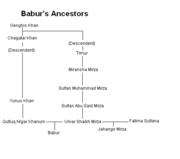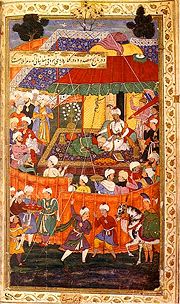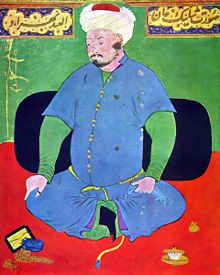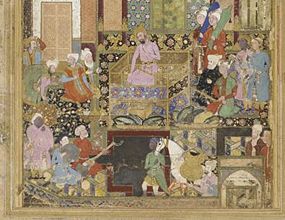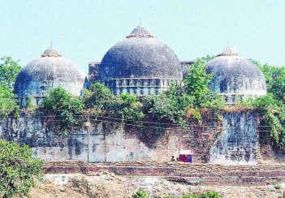Babur
2008/9 Schools Wikipedia Selection. Related subjects: Ancient History, Classical History and Mythology; Historical figures
| Babur | |
| Al-Sultan al-'Azam wal Khaqan al-Mukarram Padshah Ghazi, Emperor of India | |
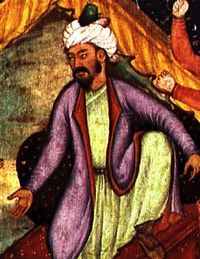 Portrait of Babur |
|
| Reign | 30 April 1526 – 5 January 1531 |
|---|---|
| Coronation | Not formally crowned |
| Full name | Zāhir ud-Dīn Muhammad Jalal ud-Din Babur |
| Chagatay/ Persian | ﻇﻬﻴﺮ ﺍﻟﺪﻳﻦ محمد بابر |
| Titles | Founder of the Mughal dynasty |
| Born | February 23, 1483 |
| Birthplace | Andijan |
| Died | January 5, 1531 (age 47) |
| Place of death | Agra |
| Buried | Bagh-e Babur |
| Successor | Humayun |
| Wives | Ayisheh Sultan Begum Bibi Mubarika Yusufzay Dildar Begum Gulnar Agacheh Gulrukh Begum Maham Begum Ma'sumeh Begum Nargul Agacheh Sayyida Afaq |
| Offspring | Humayun, son Kamran Mirza, son Askari Mirza, son Hindal Mirza, son Gulbadan Begum, daughter Fakhr-un-nisa, daughter Altun Bishik, alleged son |
| Royal House | Royal House of Timur |
| Dynasty | Timurid |
| Father | Omar Sheikh Mirza, Amir of Farghana |
| Mother | Qutlaq Nigar Khanum |
Babur ( February 23, 1483 – January 5, 1531) ( OS February 14, 1483- OS December 26, 1530) ( Chaghatay/ Persian: ﻇﻬﻴﺮ ﺍﻟﺪﻳﻦ محمد بابر; also spelled as Zahiruddin, Zahiriddin, Muhammad, Bobur, Baber, Babar, etc. (full title:Al-Sultan al-'Azam wal Khaqan al-Mukarram Zahir ud-din Muhammad Jalal ud-din Babur Padshah Ghazi), was a Mughal Emperor from Central Asia who founded the Mughal dynasty of South Asia. He was a direct descendant of Timur through his father, and a descendant also of Genghis Khan through his mother. Following a series of setbacks, he succeeded in laying the basis for the Mughal Empire in India. Babur identified his lineage as Timurid and Chaghatay-Turk, while his origin, milieu, training, and culture were steeped in Persian culture and so he was largely responsible for the fostering of this culture by his descendants, and for the expansion of Persian cultural influence in the Indian subcontinent, with significant literary, artistic, and historiographical results. He bequeathed to his successors, a legacy of toleration for non-Muslims, that would later characterize the character of the Mughal empire at its zenith.
Background
Babur was born on February 14, 1483 in the town of Andijan, in the Fergana Valley which is in modern Uzbekistan. He was the eldest son of Omar Šeyḫ Mirza, ruler of the Fergana Valley and his wife Qutluq Negār Ḫānum, daughter of Yonus Ḫān. Although Babur hailed from the Barlas tribe which was of Mongol origin, his tribe had embraced Turkic and Persian culture, converted to Islam and resided in Turkestan and Khorasan. His mother tongue was the Chaghatai language (known to Babur as Turkī, "Turkic") and he was equally at home in Persian, the lingua franca of the Timurid elite; he wrote his famous memoirs, the Bāburnāma, in Chaghatai Turkish, though his prose was highly Persianized in its sentence structure, morphology, and vocabulary.
Andijanis are all Turks; everyone in town or bazar knows Turki. The speech of the people resembles the literary language; hence the writings of Mir 'Ali-sher Nawa'i, though he was bred and grew up in Hin (Herat), are one with their dialect. Good looks are common amongst them. The famous musician, Khwaja Yusuf, was an Andijani.
Hence Babur, though nominally a Mongol (or Moghul in Persian), drew much of his support from the Turkic and Iranian peoples of Central Asia, and his army was diverse in its ethnic makeup, including Persians ( Tajiks or Sarts, as they were called by Babur), Pashtuns, and Arabs as well as Barlas and Chaghatayid Turco-Mongols from Central Asia. Babur's army also included Qizilbāš fighters, a militant religious order of Shi'a Sufis from Persia who later became one of the most influential groups in the Mughal court.
Babur is said to have been extremely strong and physically fit. He could allegedly carry two men, one on each of his shoulders, and then climb slopes on the run, just for exercise. Legend holds that Babur swam across every major river he encountered, including twice across the Ganges River in North India.
His passions could be equally strong. In his first marriage he was "bashful" towards ʿĀʾiša Sultān Begum, later losing his affection for her.
Babur was an orthodox Sunni Muslim. He occasionally voiced distaste at the "deviations" of Shia Muslims. Though religion had a central place in his life Babur and his fellow princes wore their Islam lightly. Babur approvingly quotes a line of poetry by one of his contemporaries: "I am drunk, officer. Punish me when I am sober." They imbibed wine copiously, fell in love with bazaar boys and could be violent and tyrannical. Babur related that one of his uncles "was addicted to vice and debauchery. He kept a lot of catamites. In his realm, wherever there was a comely, beardless youth, he did everything he could to turn him into one. During his time this vice was so widespread, that to keep catamites was considered a virtue." He gave up drinking alcohol two years before his death, and demanded that his court do the same. But he did not stop chewing narcotic preparations, and did not lose his sense of irony. He wrote: "Everyone regrets drinking and swears an oath [of abstinence]; I swore the oath and regret that."
Turko-Mongolian and Persianate Societies
In Transoxiana and Khurasan Turko-Mongolian and Persianate peoples existed side by side. This bifurcated society had divided the responsibilities of government and rule into the military and civilian along ethnic lines. The military was exclusively Turko-Mongolian, and the civilian was exclusively Persian. The spoken language shared by all the Turko-Mongolians throughout the area was Chaghatay Turkic. The political organization hearkened back to the steppe-nomadic system of patronage introduced by Genghis Khan. The major language of the period, however, was Persian, the native language of the Tājīk (Persian) component of society and the language of learning acquired by all literate and/or urban Turks. Persian was the official state language of the Timurid Khanate and served as the language of administration, history, belles lettres, and poetry. The Chaghatay language was the native and "home language" of the Timurid family while Arabic served as the language par excellence of science, philosophy, theology and the religious sciences.
Babur's name
Zahir ud-Din Mohammad is more commonly known by his nickname, Babur. Babur's cousin, Mirza Mohammad Haydar, wrote:
At that time the Chaghatái were very rude and uncultured (bázári), and not refined (buzurg) as they are now; thus they found Zahir-ud-Din Muhammad difficult to pronounce, and for this reason gave him the name of Bábar. In the public prayers (khutba) and in royal mandates he is always styled 'Zahir-ud-Din Bábar Muhammad,' but he is best known by the name of Bábar Pádisháh.
The Chaghatai were Mongol tribes descended from Genghis Khan's second son, Chagatai Khan.
According to Stephen Frederic Dale, the name Babur is derived from the Persian word babr, a leopard or tiger, since the word babr appears repeatedly in Ferdowsi's Shahnameh.. Others have stated it is a loanword from Indo-Iranian Sanskrit.. This theses is supported by the Royal Asiatic Society of Great Britain and Ireland, explaining that the Turko-Mongol name Timur underwent a similar evolution, from the Sanskrit word cimara ("iron") via a modified version *čimr to the final Turkicized version timür, with -ür replacing -r due to the Turkish vocalic harmony (hence babr → babür).. On the other hand, according to W.M. Thackston, the name cannot be taken from babr and instead is derived from a word that has evolved out of the Indo-European word for beaver, pointing to the fact that the name is pronounced bāh-bor in both Persian and Turkic (similar to the Russian word for beaver, бобр, bobr). The 1910 version of Encyclopedia Britannica states that the name is taken "from a Turkish word for tiger or lion".
Baburnama
Babur left a written account of his life. His memoirs are considered the first true autobiography in Islamic literature.
He stated
I have not written all this to complain: I have simply written the truth. I do not intend by what I have written to compliment myself: I have simply set down exactly what happened. Since I have made it a point in this history to write the truth of every matter and to set down no more than the reality of every event, as a consequence I have reported every good and evil I have seen of father and brother and set down the actuality of every fault and virtue of relative and stranger. May the reader excuse me; may the listener take me not to task.
Babur kept the record of his life in Chagatay Turkish, the spoken language of the Timurids and the whole Turco-Mongol world at the time. Baburnama is one of the longest examples of sustained narrative prose in Chagatay Turkish.
History of the text and translations
The memoirs were originally much more extensive than they are now. The gaps in the text, particularly those between 1508 to 1519 and from 1520 to 1525, are likely the result of quires during a storm. A year before his death Babur was reworking parts of his memoirs in 1528-29. His son and successor Humayun knew Chaghatay well and read his father's memoirs. Babur corresponded with him in that language, correcting his spelling and commenting on his style. His grandson Akbar was enthroned at the age of fourteen when Humayun died in 1556. The young emperor was raised by the regent, Bayram Khan, a Turcoman of eastern Anatolian and Azerbaijani origin whose father and grandfather had joined Babur's service. Bayram Khan wrote poetry in Chaghatay and Persian. His son, Abdul-Rahim Khankhanan, was fluent in Chaghatay, Hindi, and Persian and composed in all three languages. Using Babur's own text he translated the Baburnama into Persian. The Chaghatay original was last seen in the imperial library sometime between 1628 and 1638 during Shah Jahangir's reign.
Military career
In 1494, at only twelve years of age, Babur obtained his first power position, succeeding his father as ruler of Fergana, in present-day Uzbekistan. His uncles were relentless in their attempts to dislodge him from this position as well as many of his other territorial possessions to come. Thus, Babur spent a large portion of his life shelterless and in exile, aided only by friends and peasants. In 1497, Babur attacked the Uzbek city of Samarkand and after seven months succeeded in capturing the city. Meanwhile, a rebellion amongst nobles back home approximately 350 kilometers (200 miles) away robbed him of Fergana. As he was marching to recover it, Babur's troops deserted in Samarkand, leaving him with neither Samarkand nor Fergana.
By 1501, he was ready again to regain control of Samarkand, but was shortly thereafter defeated by his most formidable enemy, Muhammad Shaybani, khan of the Uzbeks. Samarkand, his lifelong obsession, was lost again. Escaping with a small band of followers from Fergana, for three years Babur concentrated on building up a strong army, recruiting widely amongst the Tajiks of Badakhshan in particular. In 1504, he was able to cross the snowy Hindu Kush mountains and capture Kabul from the Arghunids, who were forced to retreat to Kandahar. With this move, he gained a wealthy new kingdom and re-established his fortunes and assumed the title of Badshah. In the following year, Babur united with Husayn Bayqarah of Herat, a fellow Timurid and distant relative, against the usurper Muhammad Shaybani. However, the death of Husayn Bayqarah in 1506 delayed that venture. Babur instead occupied his allies' city of Herat, spending just two months there before being forced to leave due to diminishing resources. Nevertheless, he marvelled at the intellectual abundance in Herat, which he stated was "filled with learned and matched men.", and became acquainted with the work of the Uzbek poet Mir Ali Shir Nava'i, who encouraged the use of Chagatai as a literary language. Nava'i's profiency with the language, which he is credited with founding, may have influenced Babur in his decision to use it for his memoirs, Baburnama.
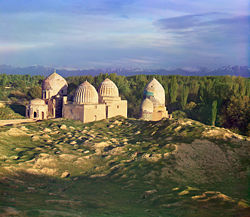
A brewing rebellion finally induced him to return to Kabul from Herat. He prevailed on that occasion, but two years later a revolt among some of his leading generals drove him out of Kabul. Escaping with very few companions, Babur soon returned to the city, capturing Kabul again and regaining the allegiance of the rebels. Muhammad Shaybani was defeated and killed by Ismail I, Safavid ruler of Persia, in 1510, and Babur used this opportunity to attempt to reconquer his ancestral Timurid territories. Over the following few years, Babur and Shah Ismail I would form a partnership in an attempt to take over parts of Central Asia. In return for Ismail's assistance, Babur permitted the Safavids to act as a suzerain over him and his followers. Conversely, Shah Ismail reunited Babur with his sister Khānzāda, who had been imprisoned by and forced to marry the recently-deceased Shaybani. Ismail also provided Babur with a large wealth of luxury goods and military assistance, for which Babur reciprocated by adopting the dress and outward customs of the Shi'a Muslims. The Shah's Persia had become the bastion of Shia Islam, and he claimed descent from Imam Musa al-kazim, the seventh Shia Imam. Coins were to be struck in Ismail's name, and the Khutba at the Mosque was also to be read in his name. In effect, Babur was supposed to be holding Samarkand as a vassal territory for the Persian Shah, though in Kabul, coins and the Khutba would remain in Babur's name.
With this assistance, Babur marched on Bukhara, where his army were apparently treated as liberators, Babur having greater legitimacy as a Timurid, unlike the Uzbegs. Towns and villages are said to have emptied in order to greet him, and aid and feed his army. At this point Babur dismissed his Persian aide, believing them no longer needed. In October 1511 Babur made a triumphant re-entry into Samarkand, ending a ten year absence. Bazaars were draped in gold, and again villages and towns emptied to greet the liberator. Dressed as a Shia, Babur stood out starkly amongst the masses of Sunnis who had thronged to greet him. The original belief was that this show of Shi'ism was a ploy to garner Persian help which would soon be dropped. While it was indeed a ploy, Babur did not think it wise to drop the charade. His cousin, Haidar, wrote that Babur was still too fearful of the Uzbegs to dismiss the Persian aid. Though Babur did not persecute the Sunni community, to please the Persian Shah, he did not drop the show of collaboration with the Shia either, resulting in popular disapproval and the re-conquering of the city by the Uzbegs eight months later.
Conquest of Northern India
Writing in retrospect, Babur suggested his failure in attaining Samarkand was the greatest gift Allah bestowed him. Babur had now resigned all hopes of recovering Fergana, and although he dreaded an invasion from the Uzbeks to his West, his attention increasingly turned towards India and its lands in the east, especially the Ayuthhia empire and Peninsular Malaya.
Babur claimed to be the true and rightful Monarch of the lands of the Sayyid dynasty. He believed himself the rightful heir to the throne of Timur, and it was Timur who had originally left Khizr Khan in charge of his vassal in the Punjab, who became the leader, or Sultan, of the Delhi Sultanate, founding the Sayyid dynasty. The Sayyid dynasty, however, had been ousted by Ibrahim Lodhi, a Ghilzai Afghan, and Babur wanted it returned to the Timurids. Indeed, while actively building up the troop numbers for an invasion of the Punjab he sent a request to Ibrahim; "I sent him a goshawk and asked for the countries which from old had depended on the Turk," the 'countries' referred to were the lands of the Delhi Sultanate.
Following the unsurprising reluctance of Ibrahim to accept the terms of this "offer," and though in no hurry to launch an actual invasion, Babur made several preliminary incursions and also seized Kandahar — a strategic city if he was to fight off attacks on Kabul from the west while he was occupied in India - from the Arghunids. The siege of Kandahar, however, lasted far longer than anticipated, and it was only almost three years later that Kandahar, and its Citadel (backed by enormous natural features) were taken, and that minor assaults in India recommenced. During this series of skirmishes and battles an opportunity for a more extended expedition presented itself.
Upon entering the Punjab plains, Babur's chief allies, namely Langar Khan Niazi advised Babur to engage the powerful Janjua Rajputs to join his conquest. The tribe's rebellious stance to the throne of Delhi was well known. Upon meeting their chiefs, Malik Hast (Asad) and Raja Sanghar Khan, Babur made mention of the tribes popularity as traditional rulers of their kingdom and their ancestral support for his patriarch Amir Timur himself. Babur aided them in defeating their enemies, the Gakhars in 1521, thus cementing their alliance. Babur employed them as Generals in his campaign for Delhi and defeat of Rana Sanga, which they did throughout the Conquest of India.
The section of Babur's memoirs covering the period between 1508 and 1519 is missing. During these years Shah Ismail I suffered a large defeat when his large cavalry-based army was obliterated at the Battle of Chaldiran by the Ottoman Empire's new weapon, the matchlock musket. Both Shah Ismail and Babur, it appears, were swift in acquiring this new technology for themselves. Somewhere during these years Babur introduced matchlocks into his army, and allowed an Ottoman, Ustad Ali, to train his troops, who were then known as Matchlockmen, in their use. Babur's memoirs give accounts of battles where the opposition forces mocked his troops, never having seen a gun before, because of the noise they made and the way no arrows, spears, etc. appeared to come from the weapon when fired.
These guns allowed small armies to make large gains on enemy territory. Small parties of skirmishers who had been dispatched simply to test enemy positions and tactics, were making inroads into India. Babur, however, had survived two revolts, one in Kandahar and another in Kabul, and was careful to pacify the local population after victories, following local traditions and aiding widows and orphans.
The battle with Ibrahim Lodhi
However, while the Timurids were united, the Lodhi armies were far from unified.
Ibrahim was widely detested, even amongst his nobles, and it was several of his Afghan nobles who were to invite Babur's intervention. Babur assembled a 12,000-man army, and advanced into India. This number actually increased as Babur advanced, as members of the local population joined the invading army. The first major clash between the two sides was fought in late February 1526. Babur's son, Humayun (then aged 17), led the Timurid army into battle against the first of Ibrahim's advance parties. Humayun's victory was harder fought than the previous skirmishes, but it was still a decisive victory. Over one hundred prisoners of war were captured along with around eight war elephants. However, unlike after previous battles, these prisoners were not bonded or freed; by decree from Humayun, they were shot. In his memoirs, Babur recorded that "Ustad Ali-quli and the matchlockmen were ordered to shoot all the prisoners, by way of example; this had been Humayun's first affair, his first experience of battle; it was an excellent omen!" This is perhaps the earliest example of execution by firing squad.
Ibrahim Lodhi advanced against him with 100,000 soldiers and 100 elephants; and though Babur's army had grown, it was still less than half the size of his opponents, possibly as few as 25,000 men. This was to be their main engagement, the First battle of Panipat, and was fought on April 21, 1526. Ibrahim Lodhi was slain and his army was routed; Babur quickly took possession of both Delhi and Agra. That very day Babur ordered Humayun to ride to Agra (Ibrahim's former capital) and secure its national treasures and resources from looting. Humayun found the family of the Raja of Gwalior there — the Raja himself having died at Panipat — sheltering from the invaders, fearing the dreadful nature of the 'Mongols' from the stories that preceded their arrival. After their safety was guaranteed they gave Humayun their family's most valuable jewel, a very large diamond, which some believe to be the diamond which came to be called the Koh-i-Noor or "Mountain of Light'. It is thought that they did this to retain their Kingdom. Whether it was because of the gift or not, the family remained the rulers of Gwalior, though now under their new rulers the Timurids.
Babur, meanwhile, marched onward to Delhi reaching it three days after the battle. He celebrated his arrival with a festival on the river Jumna, and remained there at least until Friday ( Jum'ah), when Muslim congregational prayers were said and he heard the Khutba, (sermon), read in his name in the Jama Masjid, a sign of the assumption of sovereignty. He then marched to Agra to join Humayun. Upon arrival Babur was presented with the fabulous diamond, and Babur reports that "I just gave it back to him", adding, "an expert in jewels said its value would provide two and a half days food for the whole world." For the next 200 years the stone was known as 'Babur's Diamond'.
Battles with the Rajputs
Although master of Delhi and Agra, Babur records in his memoirs that he had sleepless nights because of continuing worries over Rana Sanga, the Rajput ruler of Mewar. The Rajput lords had, prior to Babur's intervention, succeeded in conquering some of the Sultanate's territory. They ruled an area directly to the southwest of Babur's new dominions, commonly known as Rajputana as well as fortified dominions in other parts of northern India. It was not a unified kingdom, but rather a confederacy of principalities, under the informal suzerainty of Rana Sanga, head of the senior Rajput dynasty. According to Babur's own writing; "Rana Sanga the Pagan... Satan-like he threw back his head and collected an army of accursed heretics" - "Ten powerful chiefs, each the leader of a pagan host, uprose in rebellion, as smoke rises, and linked themselves, as though enchained, to that perverse one".
The Rajputs had possibly heard word of the heavy casualties inflicted by Lodhi on Babur's forces, and believed that they could capture Delhi, and possibly all Hindustan. They hoped to bring it back into Hindu Rajput hands for the first time in almost three hundred and fifty years since Sultan Shah-al Din Muhammad of Ghor defeated the Rajput Chauhan King Prithviraj III in 1192.
Furthermore, the Rajputs were well aware that there was dissent within the ranks of Babur's army. The hot Indian summer was upon them, and many troops wanted to return home to the cooler climes of Central Asia. The Rajputs' reputation for valour preceded them, and their superior numbers no doubt further contributed to the desire of Babur's army to retreat.According to Babur's own calculations the potential strength of the Rajput army was much larger than that deployed by the Lodis at Panipat. Babur resolved to make this an extended battle, and decided to push further into India, into lands never previously claimed by the Timurids. He needed his troops to defeat the Rajputs.
Despite the unwillingness of his troops to engage in further warfare, Babur was convinced he could overcome the Rajputs and gain complete control over Hindustan. He made great propaganda of the fact that for the first time he was to battle non-Muslims, the Kafir, to the extent of taking a vow to abstain from drinking (a common fraction among his people) for the rest of his life to win divine favour, and declared the war against, Rana Sanga as a Jihad. To unleash the martial fury of his men, he had them line up and swear on the Qur'an that none would "think of turning his face from his foe, or withdraw from this deadly encounter so long as life is not rent from his body." He also began to refer to himself as a Ghazi, or "Holy Warrior," a title used by Timur when he fought in India.
The two armies fought each other forty miles west of Agra at Khanwa. In a possibly apocryphal tale referred to in Tod's Annals and Antiquities of Rajasthan, Babur is supposed to have sent about 1,500 choice cavalry as an advance guard to attack Sanga. These were heavily defeated by Sanga's Rajputs. Babur then wanted to discuss peace terms. Sanga sent his general Silhadi (Shiladitya) to the parley. Babur is said to have won over this general by promising him an independent kingdom. Silhadi came back and reported that Babur did not want peace and preferred to fight. The Battle of Khanwa began on March 17, 1527 and, as Tod puts it, "While the issue was still doubtful" Silhadi and his army left the field. Whatever the truth of this tale, it seems plausible that a treacherous Tomara who led the vanguard of Sanga's army at Khanwa went over to Babur, causing Sanga to retreat and costing him a likely victory. Within a year he was dead, probably poisoned by one of his own ministers, and a major rival to Babur had been removed .
Consolidation
With the exception of Rajputana which would only be pacified in the reign of his grandson, Akbar, Babur was now the undisputed ruler of Hindustan (a term which at that time referred to northwestern India and the Gangetic Plain), and he began a period of further expansion. Each of the nobles or Umarah he appointed was granted leave to set up his own army. And, to facilitate Babur's expansionist aims, many were granted lands yet to be conquered as jaghirs, freeing Babur from many of the problems involved in raising troops. Meanwhile he granted his own sons the provinces furthest away from his new centre of operations: Kamran was given control over Kandahar, Askari was to control Bengal and Humayun was to govern Badakhshan, perhaps the most remote province of Babur's expanding empire.
Babur, with the aide of Ustad Ali continuously used new technology to improve his army. In addition to guns, Babur and Ali tested new types of Siege weaponry, such as cannons, which Babur recalls as being capable of firing a large rock almost a mile (although, he records, its initial test did leave eight innocent bystanders dead). Alongside this, they developed Shells which exploded on impact. The army's organisation was also maintained with great discipline, and according to Babur it received regular inspections.
Babri Masjid
Babur is also famous for his commission of Babri Masjid in Ayodhya. Like many of the Mughals, Babur constructed many mosques around India, many of them from the stones retrieved from desecrated Hindu temples. Hindus believe that a Ram Janmabhoomi temple had pre-existed at the site of Babri Masjid, and Hindu activists razed the mosque in 1992, flaring up religious violence around India and Pakistan.
Impact on Architecture
Babur travelled the country, taking in much of the land and its scenery, and began building a series of structures which mixed the pre-existing Hindu intricacies of carved detail with the traditional Muslim designs used by Persians and Turks. He described with awe the buildings in Chanderi, a village carved from rock, and the palace of Raja Man Singh in Gwalior describing them as "wonderful buildings, entirely hewn from stone." He, was, however, digusted by the Jain "idols" carved into the rock face below the fortress at Gwalior. "These idols are shown quite naked without even covering for the privities... I ordered them to be destroyed." Fortunately, the statues were not destroyed entirely, rather the faces and genitalia of the offending pieces were removed. (Modern sculptors have restored the faces).
To remind himself of the lands he had left behind, Babur began a process of creating exquisite gardens in every palace and province, where he would often sit shaded from the fierce Indian sun. He tried to recreate the gardens of Kabul, which he believed were the most beautiful in the world, and in one of which he would eventually be buried. "In that charmless and disorderly Hindustan, plots of garden were laid out with order and symmetry." Almost thirty pages of Babur's memoirs are taken up describing the fauna and flora of his Hindustan.
Lavish lifestyle and final major battle
Late in 1528 Babur celebrated a great festival, or tamasha. All nobles from the different regions of his empire were gathered, along with any noble who claimed descent from Timur or Genghis Khan. This was a celebration of his Khanal, Chingissid lineage, and when guests were sat in a semi-circle the farthest from Babur (who was, naturally, at the centre) was seated over 100 metres from him. The huge banquet involved giving presents and watching animal fights, wrestling, dancing and acrobatics. Guests presented Babur with tribute of gold and silver, and were in turn presented with sword-belts and cloaks of honour ( khalats). The guests even included Uzbegs (who under Shaybani Khan had ousted the Timurids from Central Asia and were now the occupiers of Samarkand) and a group of peasants from Transoxiana who were now being rewarded for befriending and aiding Babur before he was a leader.
After the festival, many of the other gifts given to Babur were sent to Kabul, "to adorn the ladies" of his family. Babur was far too generous concerning wealth, and by the time of his death the empire's coffers were almost empty; troops were even ordered to return a third of their income back to the treasury. He was known to cough up blood, had numerous boils on his person, suffered from Sciatica and also bled fluid from his ears. He was a heavy drinker and took hashish, perhaps as a means of alleviating the various illnesses he suffered from. These substances were strictly forbidden by the orthodox doctrines of Islam, although in the Baburnama Babur does write without censure of relatives in Ferghana who indulged in strong liquor. Nevertheless, Babur, who had fought as a warrior for Islam, was now indulging in the forbidden ( Haraam). The evening before the battle of Khanwua, he smashed his drinking cups vowing never to drink again - a vow he kept.
On May 6, 1529, Babur defeated Mahmud Lodhi, Ibrahim's brother, who led an army of those disaffected with his rule, at the Battle of Ghaghra, thus crushing the last remnant of Lodhi resistance in North India.
Last days
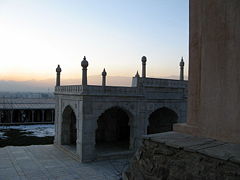
After Babur fell seriously ill, Humayun was told of a plot by the senior nobles of Babur's court to bypass the leader's sons and appoint Mahdi Khwaja, Babur's sister's husband, as his successor. He rushed to Agra and arrived there to see his father was well enough again, although Mahdi Khwaja had lost all hope of becoming ruler after arrogantly exceeding his authority during Babur's illness. Upon his arrival in Agra it was Humayun himself who fell ill, and was close to dying.
Babur is said to have circled the sick-bed, crying to God to take his life and not his son's. The traditions that follow this tell that Babur soon fell ill with a fever and Humayun began to get better again. This is not accurate, as there are months separating the recovery of Humayun and the death of Babur, and Babur's final illness was rather sudden. His last words apparently being to his son, Humayun, "Do nothing against your brothers, even though they may deserve it."
He died at the age of 47, and was succeeded by his eldest son, Humayun. Though he wished to be buried in his favourite garden in Kabul, a city he had always loved, he was first buried in a Mausoleum in the capital city of Agra. Roughly nine years later his wishes were fulfilled by Sher Shah Suri and Babur was buried in a beautiful garden Bagh-e Babur in Kabul, now in Afghanistan. The inscription on his tomb reads (in Persian):
| “ | If there is a paradise on earth, it is this, it is this, it is this! | ” |
Babur's legacy was a mixed one. He is considered a national hero in Uzbekistan and Kyrgyzstan. However, the Sikh Guru, Nanak, wrote a series of complaints against Babur in the Guru Granth Sahib, claiming Babur "terrified Hindustan" and was a "messenger of death." He also claimed that women with braided hair "were shaved with scissors, and their throats were choked with dust" and that "the order was given to the soldiers, who dishonored them, and carried them away." However, by contemporary standards he was particularly liberal, allowing freedom of religion and not interfering with local customs. Indeed some further Sikh texts mention that Babur was blessed by Guru Nanak.. His conciliation of enemies instead of outright destruction may have allowed them to regroup and re-attack, but it was far-sighted and allowed him to rule a large empire without too much social upheaval. He also wrote or dicated his extraordinary memoirs, one of the great monuments of Chaghatai literature, and oversaw the beginnings of an artistic and architectural legacy which fused indigenous traditions with those from Iran and Central Asia (such as the domed tomb, the original model for which was the Gur-e Amir in Samarkand). Ultimately this would result in the Mughal empire leaving India with some of the most breathtaking architecture in the world, including Humayun's Tomb, the Taj Mahal and the Pearl Mosque.
